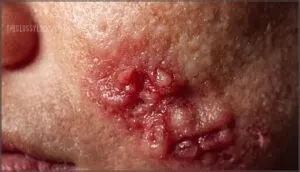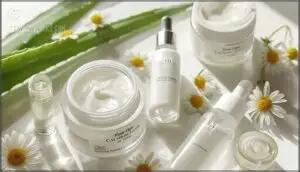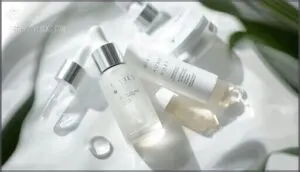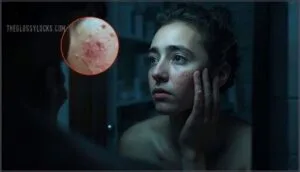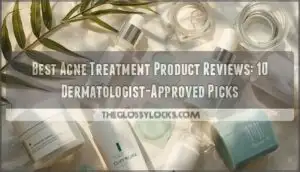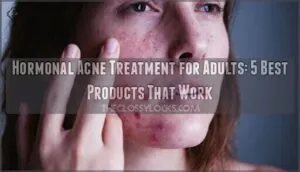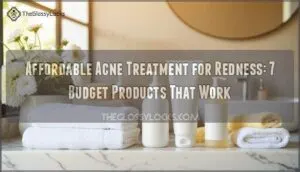This site is supported by our readers. We may earn a commission, at no cost to you, if you purchase through links.
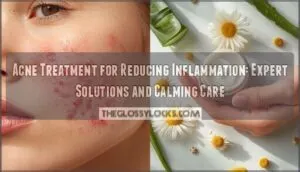
Far from a surface-level skirmish, acne inflammation weaves together everything from hormone surges to environmental irritants, making breakouts feel both unpredictable and relentless.
Understanding why these fiery flare-ups happen—and how targeted acne treatment for reducing inflammation can calm the chaos—is the first step toward reclaiming control over your skin’s future.
Table Of Contents
- Key Takeaways
- What Causes Inflammation in Acne?
- How Inflammation Worsens Acne Symptoms
- Topical Treatments to Reduce Acne Inflammation
- Oral and Systemic Anti-Inflammatory Options
- Advanced Therapies Targeting Inflammatory Acne
- Lifestyle and Skincare Strategies for Calming Inflammation
- When to Seek Professional Help for Acne Inflammation
- Frequently Asked Questions (FAQs)
- Conclusion
Key Takeaways
- Inflammation in acne is driven by a mix of excess sebum, bacterial growth, immune overactivity, and hormone or environmental triggers.
- Lasting inflammation can turn mild breakouts into painful nodules, increase scarring risk, and cause dark marks that linger long after pimples clear.
- Topical treatments like retinoids, targeted cleansers, and spot solutions help calm redness and swelling, while oral medications and advanced therapies tackle tougher or deeper inflammation.
- Consistent moisturizing, healthy lifestyle habits, and early professional care all make a meaningful difference in controlling flare-ups and supporting your skin’s healing journey.
What Causes Inflammation in Acne?
Inflammation is at the heart of what makes acne uncomfortable and often more noticeable. Several key factors join forces to trigger redness and swelling beneath the surface.
Here’s what you should know about where that inflammation really begins.
Role of Sebum and Clogged Pores
Every bout of acne has a story rooted in your skin’s chemistry. When sebum composition changes—growing heavier in squalene and triglycerides—combine that with hyperkeratinization, and pores get blocked. Oxidized lipids drive irritation, while erratic follicular dynamics feed the cycle. Lipid comedogenicity ensures these blockages provoke inflammation, keeping you searching for that elusive antiinflammatory calm. Excess sebum production can lead to clogged pores.
- Frustration with persistent oil and clogged pores
- Anxiety over new breakouts cropping up overnight
- Exhaustion from treatments that never quite work
- Hope for clearer, calmer skin with the right strategy
Bacterial Involvement (Cutibacterium Acnes)
Once your pores clog, Cutibacterium acnes finds its foothold. Certain C. acnes phylotypes—especially IA1—ignite more inflammation by triggering cytokine activation and amping up enzyme production.
Biofilm formation by these bacteria shields colonies from antibacterial treatments, while increasing antibiotic resistance. For some, this means conventional antibiotics lose their edge, making inflammation even tougher to control. Antibiotic resistance varies based on geographic location.
Immune System Activation
After bacteria trigger chaos beneath the surface, your immune system leaps into action—sometimes a little too eagerly. Inflammation in acne takes off as the Cytokine Cascade ramps up, and inflammasome activity stirs the neighborhood.
B-cell subsets and polarized macrophages, especially those with high TREM2 expression, fuel this inflammatory response, weaving the immune system deeply into the cycle of acne and inflammation.
Hormonal and Environmental Triggers
While your immune response stirs up inflammation, hormones and environmental triggers pile on. Surging androgens, cyclical hormonal changes, and environmental exposures team up to aggravate flare-ups. Here’s what can turn up the heat:
- Androgen Activity
- Menstrual Cycle shifts
- Pollution Effects
- EDCs Impact (like BPA)
- Psychological Stress
These often demand specific hormonal acne treatments or antiinflammatory treatments.
How Inflammation Worsens Acne Symptoms
When inflammation takes hold in your skin, it can turn mild acne into something much more intense. Suddenly, those breakouts aren’t just breakouts—they hurt, and they last longer.
Let’s walk through what happens when inflammation ramps up your symptoms and leaves its mark.
Types of Inflammatory Acne Lesions
Inflammation in acne doesn’t play favorites—it sparks a whole cast of skin lesions, each signaling a different level of distress. Papule formation lingers as firm, red bumps, while pustule development adds pus and tenderness.
When inflammation sinks deeper, nodule severity and cystic acne surface, bringing throbbing aches. Pseudocyst management becomes vital for those rare, stubborn swellings that seem to defy quick relief or easy answers.
Connection Between Inflammation and Scarring
Persistence is the quiet villain behind acne scarring. When inflammation lingers, your skin’s immune cell dysregulation leads to more than discomfort—it signals fibroblast activation, which builds dense collagen and triggers scar-prone lesions.
The longer the inflammation sticks around, the more likely B cell involvement and repeated cycles of inflammatory acne set the stage for lasting scars. Inflammation duration, not just intensity, decides your skin’s fate.
Post-Inflammatory Hyperpigmentation
Discoloration sticks around long after breakouts clear, turning your triumph into a waiting game. Melanin deposition causes these dark marks—post-inflammatory hyperpigmentation—especially noticeable in medium to dark skin tones. To improve treatment outcomes and prevent recurrence:
- Prioritize sun protection.
- Start acne treatment early.
- Avoid skin picking.
- Use gentle topical treatments.
- Seek professional guidance when inflammation persists.
Your commitment helps fade stubborn reminders and restores clarity.
Topical Treatments to Reduce Acne Inflammation
When inflammation flares up, the right topical treatments can make all the difference. You have options that work to calm redness, swelling, and soreness right where they start.
Let’s take a closer look at some of these approaches.
Retinoids (e.g., Differin Acne Treatment Gel)
Ever feel like your skin is trying to send a message that you just can’t decipher? Enter topical retinoids—especially Differin Gel. Retinoid mechanisms actively minimize inflammation by normalizing skin function, regulating tone, and unclogging pores. Clinical efficacy and tolerability profiles are strong. You get fewer breakouts, smoother texture, and improved clarity—without sacrificing comfort.
| Retinoid Benefit | What it Means for You |
|---|---|
| Reduced Inflammation | Calmer, less red breakouts |
| Improved Tone | Fewer dark spots post-acne |
| Gentle Tolerability | Smoother skin, less irritation |
Key benefits include reduced inflammation, improved tone, and gentle tolerability, translating to calmer breakouts, fewer dark spots, and smoother skin with less irritation.
Antimicrobial and Anti-Inflammatory Agents
For calming the storm beneath your skin, you’ll want more than a single ace up your sleeve. Topical options like benzoyl peroxide and clindamycin hit acne and inflammation hard, especially in tandem—think Combination Benefits and Resistance Mitigation.
Add a touch of natural adjuncts like quercetin, or consider oral efficacy for deeper control. That’s smart acne treatment.
Over-the-Counter Cleansers (e.g., Neutrogena Oil Free Acne Face Wash)
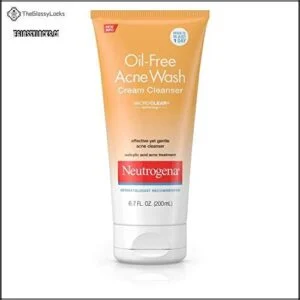
Looking for a simple step that can set the tone for calmer skin? Reach for an over-the-counter cleanser designed to do more than just wash away the day.
Formulas like Neutrogena Oil Free Acne Face Wash blend targeted cleanser ingredients—like 2% salicylic acid—with washing techniques that respect your skin type, support inflammation control, minimize irritation, and lay the groundwork for future topical treatments.
Always moisturize afterward.
Spot Treatments (e.g., Mario Badescu Drying Lotion)
Sometimes, even with a diligent cleanser routine, a stubborn pimple surfaces. That’s where spot treatments, like Mario Badescu Drying Lotion, step in.
Its ingredient synergy—salicylic acid and sulfur—targets inflammation directly. Best used as an overnight application, it dries exposed blemishes fast.
However, don’t expect it to tackle deep acne or prevent new breakouts; efficacy limitations make it a targeted, temporary fix.
Oral and Systemic Anti-Inflammatory Options
Sometimes calming acne inflammation takes more than creams and cleansers. When breakouts get stubborn or severe, your doctor may recommend oral or systemic treatments.
Here’s a look at the main options for tackling inflammation from the inside out.
Oral Antibiotics and Their Role
With oral antibiotics, you’re targeting inflammation beneath the surface, helping calm stubborn breakouts when topical approaches alone fall short. These antibiotic acne treatments work by quieting bacteria and dialing back immune overdrive, especially in moderate to severe acne. You’ll see effects maximized by:
- Mixing antibiotics with topical retinoids (combination therapies)
- Limiting treatment duration for resistance mitigation
- Watching for adverse effects, like photosensitivity or nausea
Hormonal Therapies for Inflammation
When acne’s root cause runs deep—think fluctuating hormones—targeted hormonal medications bring powerful relief. COC benefits go beyond contraception: modern birth control pills lower androgens, reducing persistent breakouts. Spironolactone efficacy stands out for women, tackling oil production at the source.
For those seeking alternatives, topical anti-androgens provide local control with less systemic impact. Progestin generations and even pediatric use now expand safe, specific hormonal therapy options.
Emerging Systemic Treatments
While hormonal medications are foundational, the wave of emerging systemic treatments is rewriting the rules, especially for inflammation unresponsive to classic oral antibiotics.
Denifanstat efficacy reshapes severe cases without retinoid drawbacks, while Biologic safety measures expand hope for the most stubborn inflammation.
Advanced peptide therapies, oral probiotics that nurture your microbiome, and retinoid alternatives with gentler profiles are pushing the boundaries of what expert acne care now means.
Advanced Therapies Targeting Inflammatory Acne
When traditional approaches aren’t enough, newer treatments can offer fresh hope for stubborn inflammatory acne. These improved options go beyond the basics and target inflammation in creative ways.
Here are some choices worth considering next.
Laser and Light-Based Treatments
Think of laser and light-based therapies as precision instruments cutting through inflammation’s chaos. Clinical effectiveness is well documented: laser mechanisms—like 577-nm diode or Nd:YAG systems—directly calm overactive sebaceous glands and reduce lesion counts.
PDT regimens, blue and red light devices, and other energy-based acne treatments offer impressive comparative efficacy. Light-based therapies, once confined to clinics, now ride a surging market trend—transforming everyday acne care.
Microneedling and Energy Devices
Beneath the skin’s surface, microneedling and sophisticated energy-based devices set the stage for repair. Microneedling’s mechanism is controlled micro-injury, boosting collagen and driving scar reduction. Among energy modalities, MNRF efficacy shines—minimizing inflammation, smoothing texture, and offering a gentler alternative to aggressive lasers.
Look for these exceptional procedural therapies:
- Fractional radiofrequency microneedling
- Hybrid ultrasound-microneedling technologies
- Biodegradable microneedle patches
Each moves the needle toward clearer, calmer skin.
Novel Topical Agents (Cannabinoids, Peptides)
Step beyond the familiar with CBD anti-inflammatories and peptide antimicrobials—each brings sophisticated benefits to topical treatments for acne and inflammation. Nano-CBD efficacy stands out for enhanced skin penetration, while peptides demonstrate potent microbial control.
When you’re weighing formulation comparisons, consider tolerability and antibacterial spectrum. Yet, despite promising results, the regulatory outlook remains cautious: in the U.S., neither cannabinoids nor peptides currently have FDA-approved acne indications.
Lifestyle and Skincare Strategies for Calming Inflammation
Tweaking your daily routine can make a real difference in how inflamed your skin feels. Sometimes, small changes to what you put on your face and how you care for yourself add up.
Here’s what to keep in mind as you look for calmer, healthier skin.
Moisturizing to Support Barrier Function
You don’t win the fight against acne by brute force—you win it by building a resilient skin barrier. When your face feels raw and tight, that’s your skin crying out for help. Regular moisturizing with ceramide-rich, niacinamide-infused formulas holds the line:
You don’t conquer acne through harshness—you protect your skin by strengthening its barrier with the right moisturizer
- Boosts skin hydration and enhances overall skin moisturization
- Reduces TEWL, locking in moisture where it counts
- Promotes lipid replenishment to restore lost skin defenses
- Improves moisturizer adherence, keeping you consistent with acne care
- Soothes irritation so treatments don’t feel like punishment
This simple act aids barrier repair, addresses inflammation, and helps you reclaim control over your skin.
Diet, Hydration, and Stress Management
Ever notice how acne and inflammation flare when life spins out of control? That’s your body waving a red flag. Dietary impact matters: diets loaded with sugar and milk stoke inflammation, while low-glycemic meals and omega-3s foster calm skin health.
Hydration effects are equally real—water aids your body’s defenses and helps sustain barrier repair, though you can’t drink your way clear.
Stress reduction isn’t a luxury; it tames oil production, helps your gut health, and improves sleep quality, defending against relentless flare-ups. When your daily habits are in balance, your skin stands a much better chance.
When to Seek Professional Help for Acne Inflammation
Sometimes, at-home care just isn’t enough to keep inflammation in check. Knowing when it’s time to call in a professional makes all the difference.
Here’s what to look out for as you consider your next steps.
Signs Your Acne Needs Medical Attention
When persistent inflammation lingers despite over-the-counter treatments, or if acne appears in unusual locations like your back or chest, it’s time to pause. Add in scarring risk, stubborn nodules, or a psychological impact—like missed events or dragging self-esteem—and a dermatologist’s expertise becomes essential.
Waiting too long can make acne and inflammation tougher to manage; timely acne management leads to better outcomes and healthier skin.
Benefits of Dermatologist-Guided Treatment
Stepping up to dermatologist-guided acne treatment means you’re not stuck guessing which topical acne treatments might work. You gain individualized assessments that fast-track your acne management, slashing wasted time on reduced trial-error approaches.
With medical-grade efficacy, combination therapies, and precisely optimized clearance, you’ll feel the difference in inflammation control—fewer side effects, fewer setbacks, and a treatment plan that finally fits with your lifestyle and skin’s real needs.
Customizing Therapy for Severe or Persistent Inflammation
When inflammation is stubborn or spreading, your dermatologist moves beyond one-size-fits-all. You’ll be guided through Severity Assessment tools that help fine-tune each combination of topical treatments, oral antibiotics, or isotretinoin based on your risk factors, previous results, and life stage.
Adherence Monitoring, regular follow-up, and special considerations—like hormonal evaluations for certain populations—make sure you’re never alone in the journey toward healthier, calmer skin.
Frequently Asked Questions (FAQs)
Are natural remedies effective for inflammatory acne?
They say the simplest answers hide in plain sight—as with natural remedies for inflammatory acne.
Tea tree efficacy, green tea benefits, aloe vera uses, honey and turmeric, and dietary changes each yield real anti-inflammatory effects when woven into your routine.
How quickly should inflammation improve after starting treatment?
You’ll usually notice some early signs of inflammation reduction within two to four weeks of starting acne treatment—especially with topical retinoid treatments or antimicrobials.
Expect clearer therapy outcomes and significant improvement in acne by the eight-to-twelve-week healing process.
Do acne patches help with inflammation reduction?
Picture a swollen blemish, shielded by a hydrocolloid pimple patch—this Patch Technology draws out moisture, calms redness, and speeds up skin healing.
For real-world Acne Management, Patch Efficacy in Inflammation Reduction is proven and user loved.
Can exercise impact inflammatory acne flare-ups?
Exercise benefits your body, but it’s a mixed bag for inflammatory acne. Sweat effects and friction (acne mechanica) can worsen breakouts, while hormonal responses and inflammation modulation from vigorous exercise sometimes make skin inflammation harder to control.
What are possible side effects of anti-inflammatory treatments?
Anti-inflammatory treatments for acne often cause topical irritation like burning and dryness, while systemic risks range from gastrointestinal upset to rare reactions. Hormonal effects, such as menstrual changes, can occur. Monitoring strategies help minimize side effects and support skin health.
Conclusion
Like a wildfire tamed with steady rain, each step toward acne treatment for reducing inflammation gradually restores calm where chaos once reigned. Progress may not come all at once, but every small victory matters.
With patience and thoughtful choices, your skin can find a new rhythm, no longer ruled by flare-ups. Trust in the science, your intuition, and the support you deserve.
This journey—challenging as it is—can uncover not just clearer skin, but renewed confidence too.
- https://www.aad.org/news/updated-guidelines-acne-management
- https://pmc.ncbi.nlm.nih.gov/articles/PMC11909303/
- https://www.frontiersin.org/journals/medicine/articles/10.3389/fmed.2024.1425675/full
- https://tfscro.com/resources/10-clinical-trials-for-acne-research/
- https://dermsquared.com/videos/topical-conversations/advances-acne-treatment-2024-highlights-what-to-watch-2025

